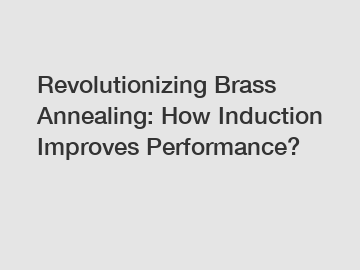Revolutionizing Brass Annealing: How Induction Improves Performance?
Revolutionizing Brass Annealing: How Induction Improves Performance?
When it comes to revolutionizing the process of brass annealing, induction technology stands out as a game-changer. Induction heating has been proved to enhance the performance of brass annealing in various ways, making it an indispensable tool for industries reliant on high-quality annealed brass products. In this article, we will delve into the reasons why induction has become the preferred method for brass annealing, highlighting its significant impact on performance and overall efficiency.
The efficiency gain achieved through induction technology is primarily attributed to its ability to deliver precise and consistent heat distribution across the material. Unlike traditional annealing methods, which mainly rely on the conductive heat transfer of hot gases or flames, induction heating utilizes an electromagnetic field to directly heat the brass to the desired temperature. This uniform heating process ensures that the entire brass piece reaches the required annealing temperature, eliminating any cold spots or unevenness that may compromise the material's quality.

The induction process begins with the use of a high-frequency alternating current that generates a magnetic field, creating a localized heat zone within the brass. The induced eddy currents in the material resist the magnetic field and generate heat due to the material's inherent electrical resistance. By precisely controlling the frequency and power of the electromagnetic field, the annealing temperature can be reached quickly and accurately, maximizing the efficiency of the process.
Furthermore, the ability to control and adjust the heat precisely throughout the annealing process is a significant advantage of induction technology. With traditional methods, temperature control is challenging, leaving room for errors and inconsistencies. However, induction heating allows for precise temperature control within a narrow range, ensuring that the ideal annealing temperature is maintained for the required amount of time. This level of control guarantees optimal softening and grain growth, resulting in improved mechanical properties and increased product reliability.
The impact of induction technology on the brass annealing process is substantial. Firstly, the uniform and controlled heat distribution achieved through induction leads to consistent material properties, reducing the risk of defects and enhancing the overall product quality. Additionally, induction heating enables faster heat cycles, significantly increasing production efficiency. The shorter annealing time, combined with the elimination of manual temperature monitoring, reduces labor costs and frees up valuable resources for other processes. This enhanced efficiency allows manufacturers to meet growing demand without compromising on quality or increasing operational costs.
In conclusion, induction technology has revolutionized the brass annealing process, offering unparalleled performance improvements. With its ability to provide precise and consistent heat distribution, improved temperature control, and increased production efficiency, induction heating has become the preferred method for industries relying on high-quality annealed brass products. Embracing this innovative technology not only ensures the production of superior brass materials but also drives overall cost-effectiveness and customer satisfaction.
Contact us to discuss your requirements of forging induction heater, china medium frequency annealing machine manufacturer, induction bends. Our experienced sales team can help you identify the options that best suit your needs.

Comments
0